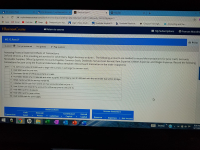
FINANCIAL ACCOUNTING
10th Edition
ISBN: 9781259964947
Author: Libby
Publisher: MCG
expand_more
expand_more
format_list_bulleted
Question
thumb_up100%
See picture for question on practice exam

Transcribed Image Text:### Assessing Financial Statement Effects of Transactions
**DeFond Services**, a firm providing art services for advertisers, began business on June 1. The following accounts are needed to record the transactions for June:
- **Cash**
- **Accounts Receivable**
- **Supplies**
- **Office Equipment**
- **Accounts Payable**
- **Common Stock**
- **Dividends**
- **Service Fees Earned**
- **Rent Expense**
- **Utilities Expense**
- **Wages Expense**
Record the following transactions for June using the financial statement effects template. (Record each transaction in the order it appears.)
#### Transactions for June:
1. **June 1:** M. DeFond invested $12,000 cash to begin the business in exchange for common stock.
2. **June 2:** Paid $950 cash for June rent.
3. **June 5:** Purchased $6,400 of office equipment on credit.
4. **June 6:** Purchased $3,800 of art materials and other supplies; the company paid $1,800 cash with the remainder due within 30 days.
5. **June 11:** Billed clients $4,700 for services rendered.
6. **June 17:** Collected $3,250 cash from clients on their accounts billed on June 11.
7. **June 20:** Paid $5,000 cash toward the account for office equipment (see June 3).
8. **June 25:** Paid $900 cash for dividends.
9. **June 26:** Paid $350 cash for June utilities.
10. **June 30:** Paid $2,500 cash for June wages.
### Graph Explanation
The **Balance Sheet** and **Income Statement** diagram shown below the transactions is used to illustrate how each transaction impacts various financial statement elements. The template includes columns for:
- **Transaction**: Chronological listing of transactions.
- **Balance Sheet**:
- **Cash**
- **Noncash Assets**
- **Liabilities**
- **Contributed Capital**
- **Earned Capital**
- **Income Statement**:
- **Revenue**
- **Expenses**
- **Net Income**
Each transaction is categorized into one or more components of the financial statements, demonstrating the effect on both the balance sheet and the income statement. For example:
- When M. DeFond invests $12,000 cash, it increases **Cash (Asset)** and **
Expert Solution
This question has been solved!
Explore an expertly crafted, step-by-step solution for a thorough understanding of key concepts.
This is a popular solution
Trending nowThis is a popular solution!
Step by stepSolved in 2 steps with 1 images

Knowledge Booster
Learn more about
Need a deep-dive on the concept behind this application? Look no further. Learn more about this topic, accounting and related others by exploring similar questions and additional content below.Recommended textbooks for you

 AccountingAccountingISBN:9781337272094Author:WARREN, Carl S., Reeve, James M., Duchac, Jonathan E.Publisher:Cengage Learning,
AccountingAccountingISBN:9781337272094Author:WARREN, Carl S., Reeve, James M., Duchac, Jonathan E.Publisher:Cengage Learning, Accounting Information SystemsAccountingISBN:9781337619202Author:Hall, James A.Publisher:Cengage Learning,
Accounting Information SystemsAccountingISBN:9781337619202Author:Hall, James A.Publisher:Cengage Learning, Horngren's Cost Accounting: A Managerial Emphasis...AccountingISBN:9780134475585Author:Srikant M. Datar, Madhav V. RajanPublisher:PEARSON
Horngren's Cost Accounting: A Managerial Emphasis...AccountingISBN:9780134475585Author:Srikant M. Datar, Madhav V. RajanPublisher:PEARSON Intermediate AccountingAccountingISBN:9781259722660Author:J. David Spiceland, Mark W. Nelson, Wayne M ThomasPublisher:McGraw-Hill Education
Intermediate AccountingAccountingISBN:9781259722660Author:J. David Spiceland, Mark W. Nelson, Wayne M ThomasPublisher:McGraw-Hill Education Financial and Managerial AccountingAccountingISBN:9781259726705Author:John J Wild, Ken W. Shaw, Barbara Chiappetta Fundamental Accounting PrinciplesPublisher:McGraw-Hill Education
Financial and Managerial AccountingAccountingISBN:9781259726705Author:John J Wild, Ken W. Shaw, Barbara Chiappetta Fundamental Accounting PrinciplesPublisher:McGraw-Hill Education


Accounting
Accounting
ISBN:9781337272094
Author:WARREN, Carl S., Reeve, James M., Duchac, Jonathan E.
Publisher:Cengage Learning,

Accounting Information Systems
Accounting
ISBN:9781337619202
Author:Hall, James A.
Publisher:Cengage Learning,

Horngren's Cost Accounting: A Managerial Emphasis...
Accounting
ISBN:9780134475585
Author:Srikant M. Datar, Madhav V. Rajan
Publisher:PEARSON

Intermediate Accounting
Accounting
ISBN:9781259722660
Author:J. David Spiceland, Mark W. Nelson, Wayne M Thomas
Publisher:McGraw-Hill Education

Financial and Managerial Accounting
Accounting
ISBN:9781259726705
Author:John J Wild, Ken W. Shaw, Barbara Chiappetta Fundamental Accounting Principles
Publisher:McGraw-Hill Education